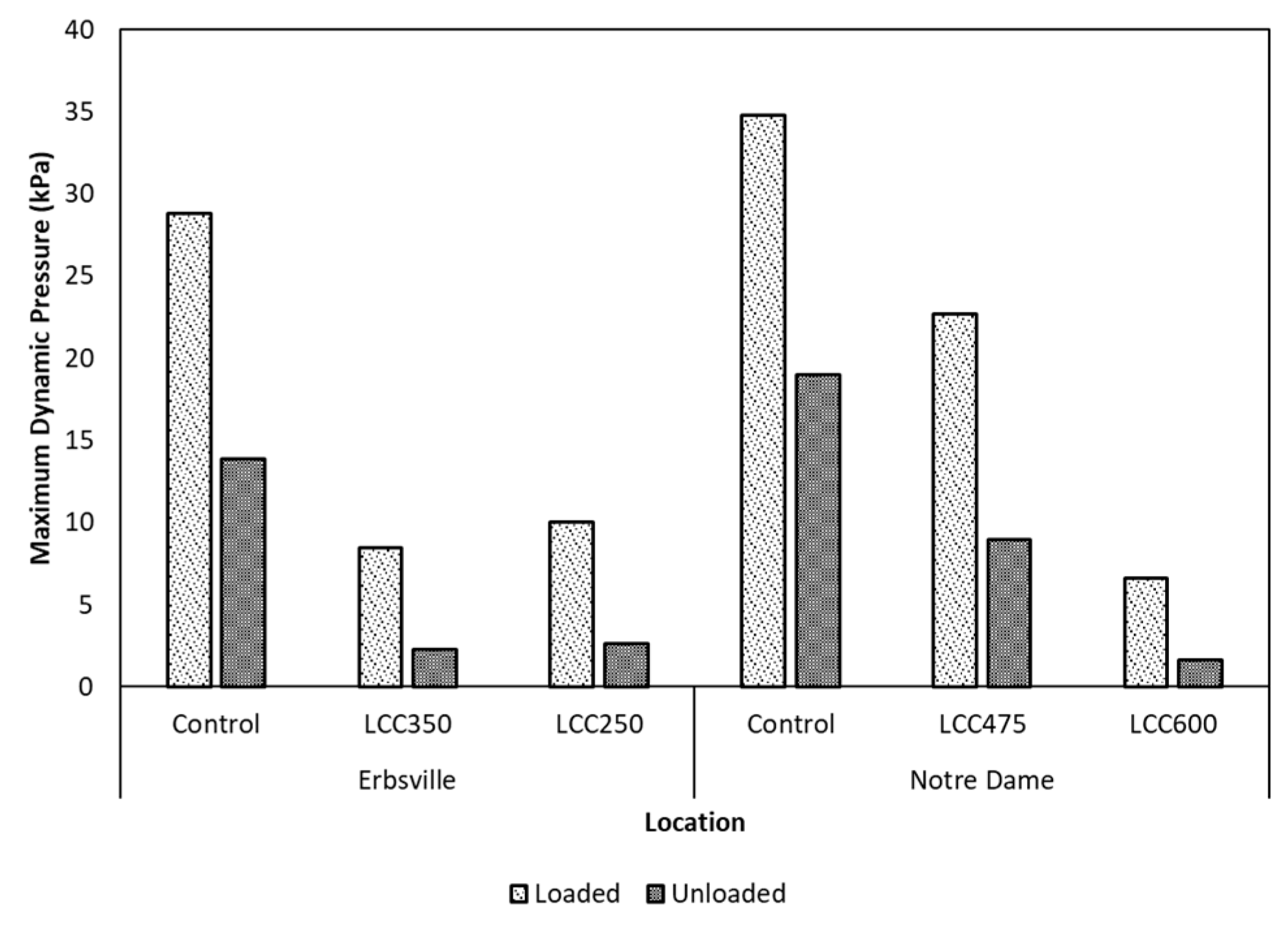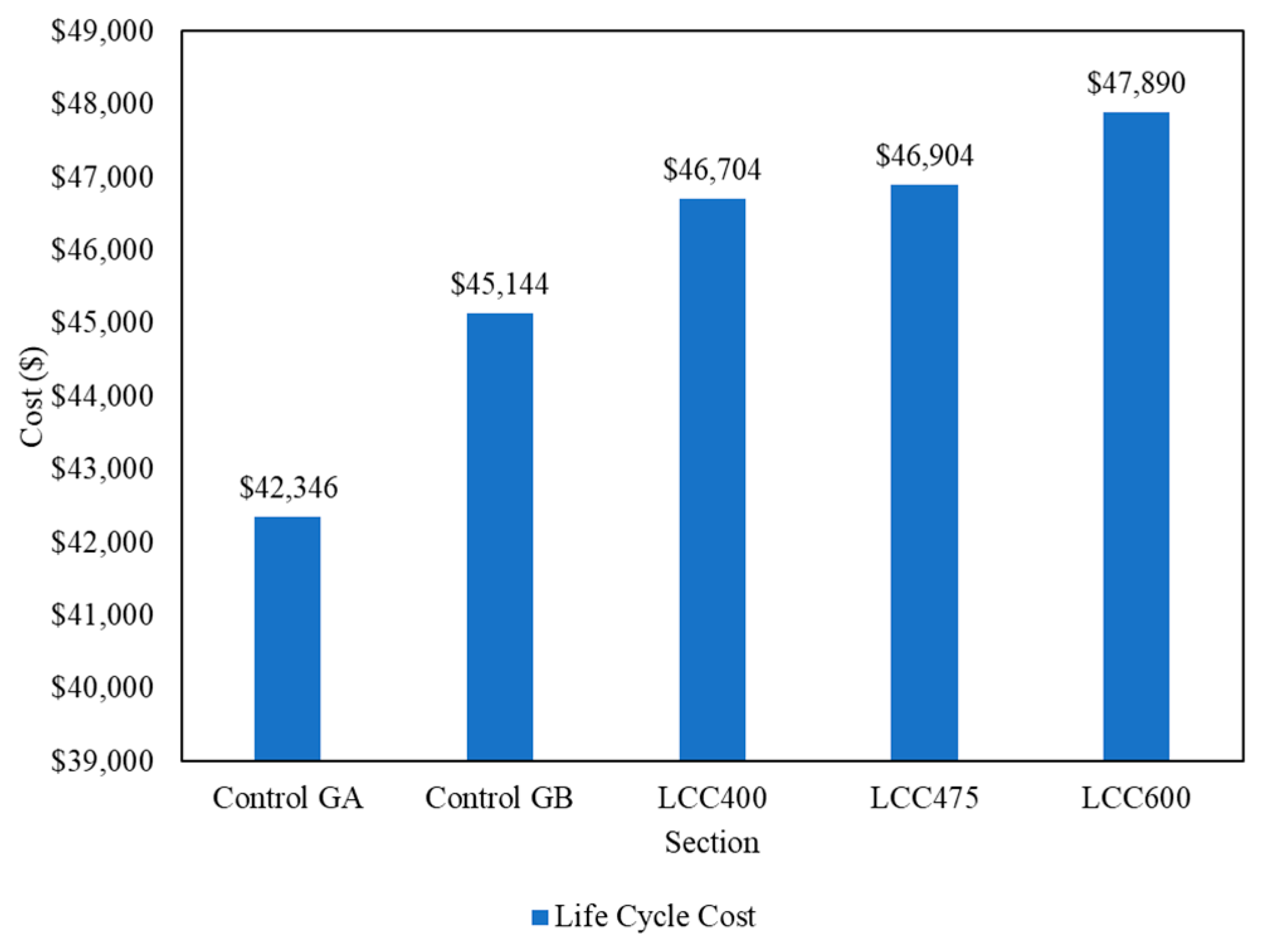1. Introduction
Lightweight cellular concrete (LCC) or foamed concrete has gained attention in pavement industries due to its low density of 375 to 1600 kg/m
3 and homogenous structure of air bubbles throughout the mixture [
1,
2]. Studies have extensively examined its mechanical properties like compressive strength and elasticity modulus [
3,
4,
5,
6]. LCC has been successfully used as an alternative subbase to unbind granular material to solve the differential settlement on roadways in various locations in Canada and around the world [
7,
8,
9,
10,
11]. LCC is proving to be an excellent alternative for pavement applications with improved bearing capacity [
12,
13]. However, there remains a requirement for a comprehensive assessment and set of recommendations for the incorporation of LCC into the design and construction of flexible pavements in Canada.
2. Investigation on Field Test Sections
In 2018 and 2021, two field test sections were constructed to evaluate the performance of LCC. The test sections involved three different densities (400, 475, and 600 kg/m
3) and thicknesses of LCC compared to the unbound granular subbase section. Different sensors were installed to monitor the pavement response and environmental conditions. The following sections summarize the findings from the construction process to post-construction performance tracking [
14,
15].
2.1. Construction Analysis
The results indicated in the past study that LCC subbase layers are a viable alternative to granular materials for reducing subgrade pressures by 78% during construction, with densities of 400 kg/m
3, 475 kg/m
3, and 600 kg/m
3 being effective [
16]. When pouring LCC at lower temperatures (≤4 °C), insulating the layers after pouring may be necessary for proper curing. LCC subbase does not hinder drainage and can even improve it. However, construction methods, processes, and excessive vehicular traffic can impact performance. Careful design modifications such as LCC thickness, construction method, and training for construction crews are necessary to ensure good performance of LCC subbase pavements and limit the duration between LCC pour and asphalt paving operations.
2.2. Field Structural Evaluation
Regarding structural capacity, Oyeyi et al. documented that using LCC as a subbase material can significantly reduce subgrade pressure caused by traffic by three times compared to unbound granular subbase pavements (
Figure 1) [
15]. The pressure reduction depends on factors such as LCC layer thickness, pavement thickness, load magnitude, load distribution, tire pressure, and material characteristics. LCC subbase layers with a thickness of less than or equal to 250 mm could be used in areas with lower traffic volumes and smaller vehicles. Increased pavement depth reduces strains, and incorporating LCC subbase layers reduces strains more than unbound granular material. However, environmental conditions like temperature and moisture can affect the stresses and strains experienced at each layer (For instance, winter to have lower strain), and further investigation is necessary.
3. Cost Analysis
Oyeyi et al. performed a life cycle assessment (LCA) for LCC pavements and compared them with the unbound granular subbase material (Granular A (GA) and B (GB)) pavements. Their results showed that up to 16% of CO
2 emission is reduced by substituting unbound granular material with LCC and reducing other harmful pollutants [
16]. Based on the same maintenance and rehabilitation (M&R) schedule in [
16], a preliminary life cycle cost assessment (LCCA) was performed.
Figure 2 demonstrates the results [
17]. This study considered only initial and M&R costs, but not the insulating capabilities of LCC which could contribute to the roadway longevity over frost susceptible subgrades.
The LCCA results showed that flexible pavement sections with granular A had between 10 and 13% and granular B between 4 and 6% lower total life cycle costs at the end of a 50-year analysis period compared with LCC subbases. The yearly cost commitment was also within the exact percentages. Initial construction contributed the most to all sections’ total lifecycle costs. The initial construction costs for the control with granular A were 15%, 18%, and 21% lower than those with 400, 475, and 600 kg/m3 LCC, respectively. These percentages were 7%, 10%, and 13% lower when using granular B. When only initial construction and maintenance LCCA phase costs were compared, the LCC sections yielded lower total life cycle costs, 400 kg/m3 (6%), 475 kg/m3 (5%), and 600 kg/m3 (3%) than the control with granular A. Similarly, it was 12%, 11%, and 9%, respectively, less than the control with granular B. The costs increased with an increase in LCC density LCC. Total lifecycle cost was sensitive to changes in the cost of subbase material. Even with a 40 % LCC cost reduction, the granular A control section remained cheaper. However, a decrease in LCC cost by 40% caused the control with granular B to become more expensive than the LCC sections.
4. Recommendation of Use
LCC subbase can be a viable alternative to traditional subbase materials when weak subgrades need insulation. Thicknesses of at least 250 mm and densities between 400–600 kg/m3 can improve performance and delay pavement failure.
Several methods can be used to design LCC subbase pavements, including granular base equivalent, MEPDG, and AASHTO 93. Linear elastic theory packages can also be used but may require adjustments. For example, WESLEA-generated strains and stresses could be reduced by a ratio of 0.2 and 0.65 for LCC between 400 and 600 kg/m3. Other tools like WESLEA, KENLAYER, and PAVEXpress for better performance interpretation should supplement MEPDG analysis.
A structural coefficient of 0.22 is recommended for designing LCC pavements between 400–600 kg/m3. The granular base equivalency strength coefficient is proposed to be 1.22 for 400 kg/m3, 1.46 for 475 kg/m3, and 1.91 for 600 kg/m3. LCC subbase thickness can be reduced by 44–65% compared to unbound granular subbase.
In total, 600 kg/m3 density LCC is recommended for major arterial roads, while minor arterial and collector roads can use 400 kg/m3 and 475 kg/m3 LCC. LCC subbase below 475 kg/m3 should be at least 250 mm thick. Strain and stress patterns within the pavement structure should be considered when deciding on density for various road conditions and classes.
The timing for opening traffic after road construction is recommended after three days for 475 kg/m3 density and 600 kg/m3 density and seven days for 400 kg/m3 density. The dry mix approach for LCC production is beneficial, and using slag or pozzolans can further reduce environmental damage.
Additionally, 475 kg/m3 LCC is proposed over 400 kg/m3 due to its stable pore structure, strength, and freeze–thaw resistance. Total lifecycle costs for 400 and 475 kg/m3 LCC are comparable and less than 600 kg/m3. Therefore, applying 475 kg/m3 LCC is recommended due to its significant difference in performance from 400 kg/m3 and relatively comparable performance to 600 kg/m3.
5. Conclusions
This paper discusses the use of lightweight cellular concrete as an alternative pavement subbase material. Literature review, findings from field test sections, and results from LCA from past studies were reviewed. It presents preliminary lifecycle cost analysis (LCCA) information and provides recommendations for LCC use with flexible pavements. For future considerations, the freeze–thaw benefit of LCC should be considered in evaluation performance, an in-depth LCCA should be performed to consider social costs and insulation benefits associated with using LCC.
Author Contributions
Conceptualization, A.G.O., F.M.-W.N., and S.T.; methodology, A.G.O. and F.M.-W.N.; software, F.M.-W.N.; validation, A.G.O. and F.M.-W.N.; writing—original draft preparation, A.G.O.; writing—review and editing, F.M.-W.N.; supervision, S.T.; project administration, S.T. All authors have read and agreed to the published version of the manuscript.
Funding
This research was funded by Natural Sciences and Engineering Research Council of Canada (NSERC)and CEMATRIX, grant number funding reference CRDPJ 514908-2017.
Institutional Review Board Statement
Not applicable.
Informed Consent Statement
Not applicable.
Data Availability Statement
Not applicable.
Acknowledgments
The authors of this research gratefully acknowledge CEMATRIX (CANADA) Inc, the Region of Waterloo, Ontario, Canada, Natural Sciences and Engineering Research Council of Canada (NSERC), and Centre for Pavement and Transportation Technology (CPATT), the University of Waterloo for supporting this research.
Conflicts of Interest
The authors declare no conflict of interest.
References
- Amran, M.; Onaizi, A.M.; Fediuk, R.; Danish, A.; Vatin, N.I.; Murali, G.; Abdelgader, H.S.; Mosaberpanah, M.A.; Cecchin, D.; Azevedo, A. An ultra-lightweight cellular concrete for geotechnical applications—A review. Case Stud. Constr. Mater. 2022, 16, e01096. [Google Scholar] [CrossRef]
- Ozlutas, K. Behaviour of Ultra-Low Density Foamed Concrete. Doctoral Dissertation, University of Dundee, Dundee, UK, 2015. [Google Scholar]
- Amran, Y.M.; Farzadnia, N.; Ali, A.A. Properties and applications of foamed concrete-a review. Constr. Build. Mater. 2015, 101, 990–1005. [Google Scholar] [CrossRef]
- Jiang, J.; Lu, Z.; Niu, Y.; Li, J.; Zhang, Y. Study on the preparation and properties of high-porosity foamed concretes based on ordinary Portland cement. Mater. Des. 2016, 92, 949–959. [Google Scholar] [CrossRef]
- Favaretto, P.; Hidalgo, G.E.N.; Sampaio, C.H.; Silva, R.D.A.; Lermen, R.T. Characterization and use of construction and demolition waste from south of Brazil in the production of foamed concrete blocks. Appl. Sci. 2017, 7, 1090. [Google Scholar] [CrossRef]
- Fu, Y.; Wang, X.; Wang, L.; Li, Y. Foam concrete: A state-of-the-art and state-of-the-practice review. Adv. Mater. Sci. Eng. 2020, 2020, 6153602. [Google Scholar] [CrossRef]
- Dolton, B.; Witchard, M.; Luzzi, D.; Smith, T.J. Application of Lightweight Cellular Concrete to Reconstruction of Settlement Prone Roadways in Victoria; GEOVANCOUVER: Vancouver, BC, Canada, 2016. [Google Scholar]
- Griffiths, F.; Popik, M. Pavement Evaluation-CEMATRIX Site Dixie Road, Caledon, Ontario; Thurber Engineering Ltd.: Caledon, ON, Canada, 2013. [Google Scholar]
- Maher, M.L.; Hagan, J.B. MAT-758: Constructability Benefits of the Use of Lightweight Foamed Concrete Fill (LFCF) in Pavement Applications. In Proceedings of the 2016 CSCE Annual Conference, London, ON, Canada, 1–4 June 2016. [Google Scholar]
- Decký, M.; Drusa, M.; Zgútová, K.; Blaško, M.; Hájek, M.; Scherfel, W. Foam concrete as new material in road constructions. Procedia Eng. 2016, 161, 428–433. [Google Scholar] [CrossRef]
- Drusa, M.; Decky, M. Designing and Quality Control of Earth Structures on Transport Constructions; Edis Uniza: Žilina-Vlčince, Slovakia, 2013; p. 522. ISBN 978-80-554-0823-1. [Google Scholar]
- Ni, F.M.; Oyeyi, A.G.; Tighe, S. Structural capacity evaluation of lightweight cellular concrete for flexible pavement subbase. Road Mater. Pavement Des. 2021, 23, 2781–2797. [Google Scholar] [CrossRef]
- Taylor, S.; Halsted, G. Guide to Lightweight Cellular Concrete for Geotechnical Applications; Portland Cement Association: Washington, DC, USA; National Concrete Pavement Technology Center at Iowa State University: Ames, IA, USA, 2021. [Google Scholar]
- Oyeyi, A.G.; Ni, F.M.; Dolton, B.; Tighe, S. Investigating the Effect of Construction Activities on Lightweight Cellular Concrete Subbase Pavements. In Proceedings of the Transportation Association of Canada 2022 Conference and Exhibition-Changing Ways for our Changing Climate//Association des transports du Canada 2022 Congrès et Exposition-Approches Adaptées pour un Climat Changeant 2022, Edmonton, AB, Canada, 2–5 October 2022. [Google Scholar]
- Oyeyi, A.G.; Ni, F.M.; Tighe, S. In-situ structural analysis of lightweight cellular concrete subbase flexible pavements. Road Mater. Pavement Des. 2023, 1–17. [Google Scholar] [CrossRef]
- Oyeyi, A.G.; Achebe, J.; Ni, F.M.; Tighe, S. Life cycle assessment of lightweight cellular concrete subbase pavements in Canada. Int. J. Pavement Eng. 2023, 24, 2168662. [Google Scholar] [CrossRef]
- Oyeyi, A.G. Lightweight Cellular Concrete as Flexible Pavement Subbase Material: Field Performance and Sustainability Study. Doctoral Dissertation, University of Waterloo, Waterloo, ON, Canada, 2022. Available online: http://hdl.handle.net/10012/18938 (accessed on 1 January 2023).
| Disclaimer/Publisher’s Note: The statements, opinions and data contained in all publications are solely those of the individual author(s) and contributor(s) and not of MDPI and/or the editor(s). MDPI and/or the editor(s) disclaim responsibility for any injury to people or property resulting from any ideas, methods, instructions or products referred to in the content. |
© 2023 by the authors. Licensee MDPI, Basel, Switzerland. This article is an open access article distributed under the terms and conditions of the Creative Commons Attribution (CC BY) license (https://creativecommons.org/licenses/by/4.0/).







